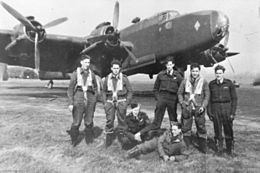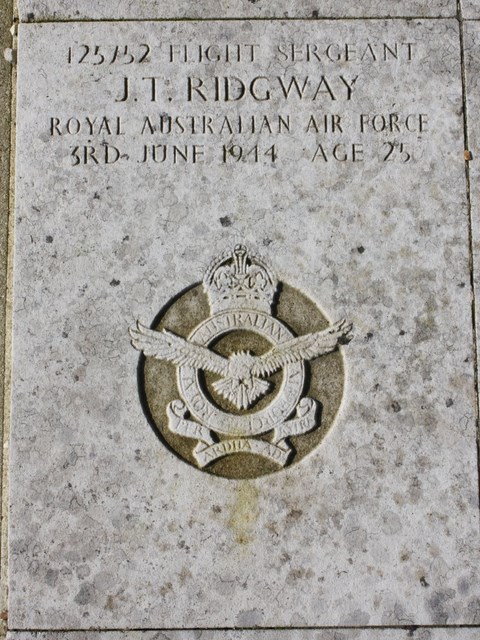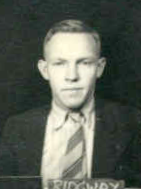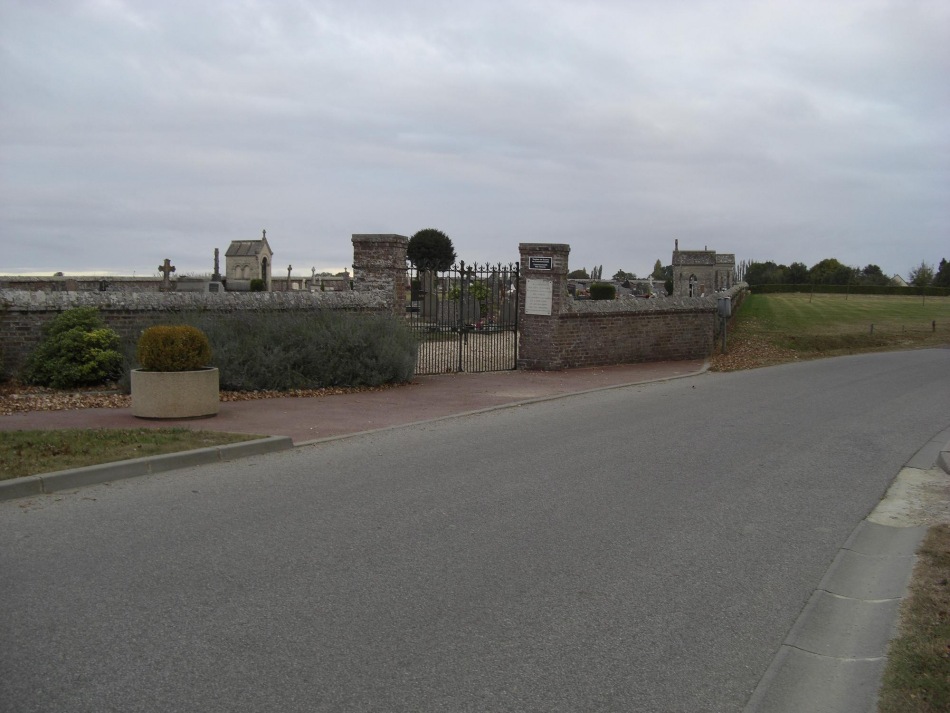Flight Sergeant Ridgway, the son of Gilbert Mark Ridgway and Rachel Ridgway (nee Goodwin), was born at on Toowoomba in Queensland on 15th August 1918. He was educated at the Toowoomba North State School during the years 1930 and 1931. He then attended the Toowoomba Grammar School in 1932 and 1933. After leaving school he was employed in several employments including Farm Hand, Shop Assistant, and a Carter for a fruit market. He applied for aircrew training in the Royal Australian Air Force in September 1941. At the time of his application he was married and living with his wife and two children at 53 Bellevue Street in Toowoomba. He was enrolled in the Reserve of the R.A.A.F. on 30th September 1941 after swearing the statutory oath of allegiance. He was issued with Reserve Badge No. 5978. At the age of 23 years and 8 months he was enlisted into the Citizen Air Force of the R.A.A.F. at No. 3 Recruiting Centre in Brisbane on 25th April 1942 after giving an undertaking that he would serve for the duration of the war and an additional twelve months. His physical description at the time of enlistment was that he was 5 feet 6 inches in height and weighed 133 pounds. He had a fair complexion, blue eyes and light brown hair. He stated that he was of the Church of England religion. He gave his next of kin as his wife and he also gave his mother, Mrs Rachel Ridgway, residing at 166 Bridge Street in Toowoomba as a person to be notified in the event of his injury or death.
Flight Sergeant John Ridgway was allotted the service number of 425752. He joined No. 3 Initial Training School at Sandgate in Queensland on 26th April 1942. He joined No. 5 Elementary Flying Training School at Narromine in New South Wales on 10th August 1942. He joined No. 2 Embarkation Depot at Bradfield Park in New South Wales on 22nd October 1942 and the proceeded to No. 1 Embarkation Depot at Ascot Vale in Victoria to prepare for overseas service on attachment to the Royal Canadian Air Force where he would continue his training. He embarked from Melbourne in Victoria on 2nd November 1942. After disembarking in Canada on 27th November 1942 he joined No. 3 Manning Depot at Edmonton in Alberta later that day. He joined No. 15 Flying Training School at Claresholm in Alberta on 1st December 1942. He was unsuccessful in becoming a Pilot and he rejoined No. 3 Manning Depot on 9th February 1943. He joined No. 7 Bombing & Gunnery School at Paulson in Manitoba on 7th March 1943. He joined No. 1 Air Observer School at Malton in Ontario on 30th May 1943. After completing his training at Malton he was awarded the Air Observer Qualification Badge and was promoted to the rank of Temporary Sergeant on 9th July 1943
Flight Sergeant John Ridgway joined No. 1 “Y” Depot at Halifax in Nova Scotia on 20th July 1943 to prepare for overseas service on attachment to the Royal Air Force. He embarked from New York in the United States on 3rd August 1943 and disembarked in England on 11th August 1943 where he joined No. 11 Personnel Despatch & Reception Centre at Bournemouth on the following day. He joined No. 4 (Observer) Advanced Flying Unit at Royal Air Force Station West Freugh on 12th October 1943. He joined No. 27 Operational Training Unit at Royal Air Force Station Lichfield on 23rd November 1943 for training in night bombing using Vickers Wellington aircraft. After completing his training at Lichfield he was promoted to the rank of Temporary Flight Sergeant on 9th January 1944. He joined No. 1652 Conversion Unit at No. 41 Base at Royal Air Force Station Marston Moor on 10th April 1944. He joined No. 466 Squadron Royal Australian Air Force at Royal Air Force Station Driffield for operational duty on 23rd May 1944.
Flight Sergeant John Ridgway was an Air Bomber and a member of the crew of No. 466 Squadron Royal Australian Air Force Haifax Bomber HX242, that was detailed to attack an enemy target at Trappes in France and failed to return to its base. The aircraft was lost at St Armand des Hautes Terres, France, on 3rd June 1944. His mother was notified by telegram on 5th June 1944 that he was missing on air operations.
The Commanding Officer of No. 466 Squadron wrote the following letter to his mother on 4th June 1944:
Dear Mrs Ridgway, Before you receive this letter, you will have been notified by the Air Board, Melbourne, that your husband, Flight Sergeant John Thomas Ridgway, was reported missing from an operational flight from this country. It is with deep regret that I am writing to confirm this unhappy news and to convey to you the heartfelt sympathy of the squadron in your great anxiety. On the night of 2nd June 1944, the aircraft in which your husband was Air Bomber, took off to carry out an attack on enemy territory. This flight represented on of the many courageous efforts called for from the Royal Australian Air Force in this war, and it was undertaken with efficiency and resolution, for which your husband and his crew were an inspiration to us all. Unfortunately the aircraft did not return. The most searching enquiries through all possible channels have so far revealed nothing, but naturally it will take some time for possible information to reach this country from enemy sources. Meanwhile, we can only hope that Flight Sergeant Ridgway and the other members of his crew are prisoners of war. May I again express my personal sympathy and profound regret, that it should fall to my lot to convey to you tidings such as these, knowing as I do what an anxious time it will mean for you. Yours sincerely, H.W. Connolly.

A 466 Squadron Halifx bomber and crew after their return from a raid on Germany.
After the war the Missing Research & Enquiry Unit investigated the scene of the crash and the two cemeteries where the remains of the crew were buried. In an attempt to positively identify the remains of the crew, exhumation of the graves was carried out. On 14th December 1946 the Casualty Section of the R.A.A.F. wrote the following letter to his wife:
Dear Madam, I refer to previous communications concerning your late husband Flight Sergeant John Thomas Ridgway. Reports have been received from the Missing Research & Enquiry Service operating in France, and although I regret to inform you of the following details contained in the reports, it is considered you would prefer to know all the available information. The reports which are based upon the interrogation of the local authorities and investigations in the area of the crash, state that your husband’s aircraft was seen approaching the village of St Armand des Hsutes Terres, in the province of Eure, France, at approximately 2 a.m. on 3rd June 1944. The aircraft suddenly exploded in mid-air presumably due to enemy action and the wreckage fell in a field approximately 3 miles west of the village. It is hoped that you will derive some small comfort in the knowledge that the nature of the explosion and subsequent crash was such that your husband and his comrades lost their lives instantly. The reports further state that individual identification of your husband and other members of his crew was not possible at the time. Upon exhumation the Missing Research & Enquiry Service was able to establish the identity of one member only, Flight Sergeant Kingham, the rear-gunner of your husband’s crew. Your husband and the other unidentified members of his crew are buried communally in the cemetery at Tourville La Compagne. When registered by the Graves Registration Unit, the graves will be marked with a cross bearing the names and service particulars of your husband and his comrades, and will be taken over and cared for in perpetuity by the Imperial War Graves Commission. Permit me to assure you of the continued sympathy of this Department in your sad loss. Yours faithfully, J.C. Perry, Acting Secretary.
Flight Sergeant John Ridgway, for his service during World War 2, had entitlement for the Air Observer Qualification Badge, the 1939/1945 Star, the Aircrew Europe Star, the Defence Medal, the War Medal and the Australian Service Medal 1939/1945. His name is commemorated on Panel No.110 at the Australian War Memorial in Canberra and locally on the Toowoomba Grammar School World War 2 Honour Board.
Toowoomba Grammar School archive records show that he enrolled as a day student on 27th January 1932, left on 23rd June 1932, and returned to the School from 31st January 1933 to 8th December 1933. His parent was shown as Mr Gilbert Mark Ridgway of Toowoomba.

F/SGT Ridgway’s grave stone.




